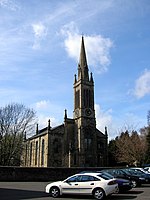Scottish Fire and Rescue Service National Training Centre
Buildings and structures in CambuslangEducational organisations based in ScotlandFire and rescue in ScotlandFirefighting academiesFirefighting stubs ... and 4 more
Organisations supported by the Scottish GovernmentScotland education stubsScotland government stubsVocational education in Scotland
The Scottish Fire and Rescue Service National Training Centre is a purpose-built training facility in Cambuslang, South Lanarkshire. Also known as the Uaill Training Centre, it has mock buildings and areas suitable for training to use specialist fire and rescue equipment. It opened in January 2013 and is operated by the Scottish Fire and Rescue Service (SFRS).
Excerpt from the Wikipedia article Scottish Fire and Rescue Service National Training Centre (License: CC BY-SA 3.0, Authors).Scottish Fire and Rescue Service National Training Centre
Westburn Drive,
Geographical coordinates (GPS) Address External links Nearby Places Show on map
Geographical coordinates (GPS)
| Latitude | Longitude |
|---|---|
| N 55.8266 ° | E -4.1585 ° |
Address
Scottish Fire and Rescue Service National Training Centre
Westburn Drive
G72 7ZT , Hallside
Scotland, United Kingdom
Open on Google Maps








